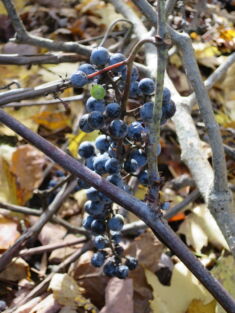Wild Grapes
Many people have a love-hate relationship with wild grapes, but love ‘em or hate ‘em, they play an important role in our natural environment. There are three species of native wild grape that occur in the Thames River region, the most common being riverbank grape (Vitis riparia). As the name suggests, it is found near rivers and streams or wherever sunlight is available. Their roots hold the soil, preventing bank erosion.
Grapes lack a strong stem so they depend on the support of trees and shrubs to reach into the tree canopy for light. Grape leaves can form a layer so thick that they prevent sunlight from reaching the host tree or plant, eventually killing it. The dead tree collapses from the weight of heavy vines, thus opening up the canopy allowing sunlight to reach the forest floor. The openings create an opportunity for tree saplings that have been waiting in the shade for years, to receive the light needed to grow, thus starting the forest cycle again.

The tiny, fragrant, greenish-white flowers of riverbank grape bloom in May and June. Once insect pollinated and fertilized, the fruit develops, turning from green to dark blue to black with a white bloom. Each berry contains one to four flat seeds. The grapes are juicy but sour until fully ripe in late September and October. They are sweetest after frost. The fruits are an important food for a variety of birds including flickers, cardinals and thrushes, and mammals. The plant readily spreads via bird droppings.
People have gathered wild grapes for centuries for the making of wine and jelly, or for eating fresh or dried. The leaves are also edible and are popular for making Mediterranean and Middle Eastern dishes. Indigenous peoples used the juice of wild grapes to soothe coughs and colds. The flexible vines are used to make baskets, wreaths and other crafts.
Riverbank grape is one of the native grape species used in rescuing the European wine industry in the late 1800s, after a North American root louse or aphid (Phylloxera) was accidentally imported to Europe. Native grapes were naturally resistant to the pest, so European vines were graphed onto North American grape rootstock, a practice still used today.
If grape vines are growing up important trees around houses or buildings, they can be easily cut at ground level. It is best to smother or treat the stump so it does not re-sprout. To avoid damaging the tree, there is no need to remove the vine as it should decay and fall away on its own.
So, no sour grapes here, let’s celebrate the native riverbank grape!
Contact: Cathy Quinlan, Terrestrial Biologist

